People
Botticelli Is Buried at the Feet of His Muse—and 9 Other Unusual Stories Behind Famous Artists’ Final Resting Places
Can you guess which artist's ashes were surreptitiously buried under the cloak of night?
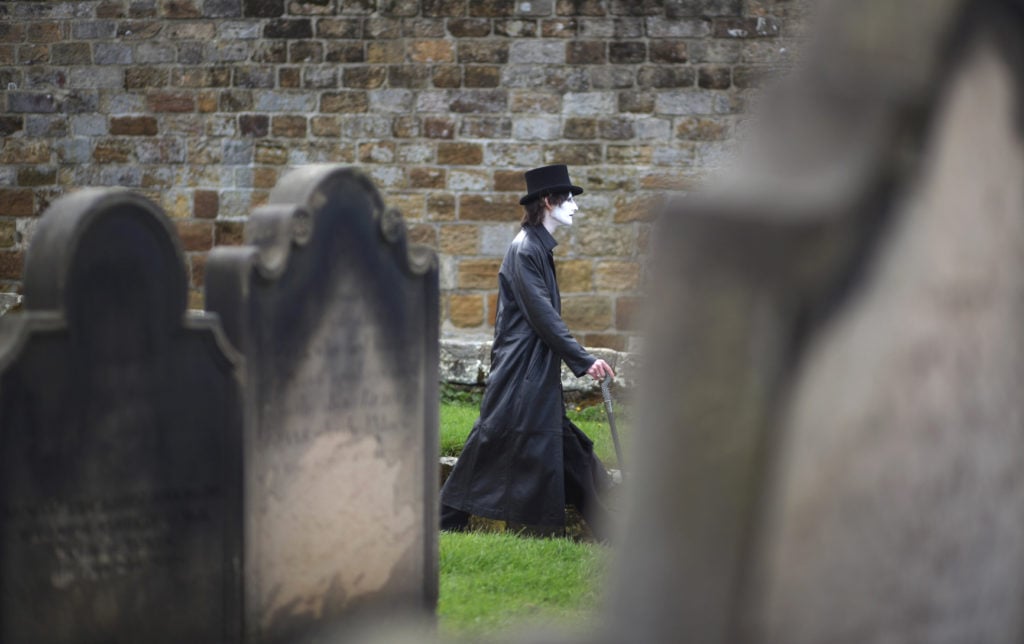
Can you guess which artist's ashes were surreptitiously buried under the cloak of night?

Katie White

“I always thought I’d like my own tombstone to be blank,” Andy Warhol once quipped. “No epitaph and no name. Well, actually, I’d like it to say ‘figment.'” While Warhol didn’t get his wish (as you’ll see below), death does become a kind of funerary performance piece for some artists. From scripted ceremonies to show-stopping tombstones, the last rites for a number of art-historically important figures offer fascinating insights into their lives and legacies.
If your interest in art extends beyond (or let’s say to) the grave, you’re in luck. Just in time for Halloween, here’s our guide to the 10 most unusual art-historical tombs.
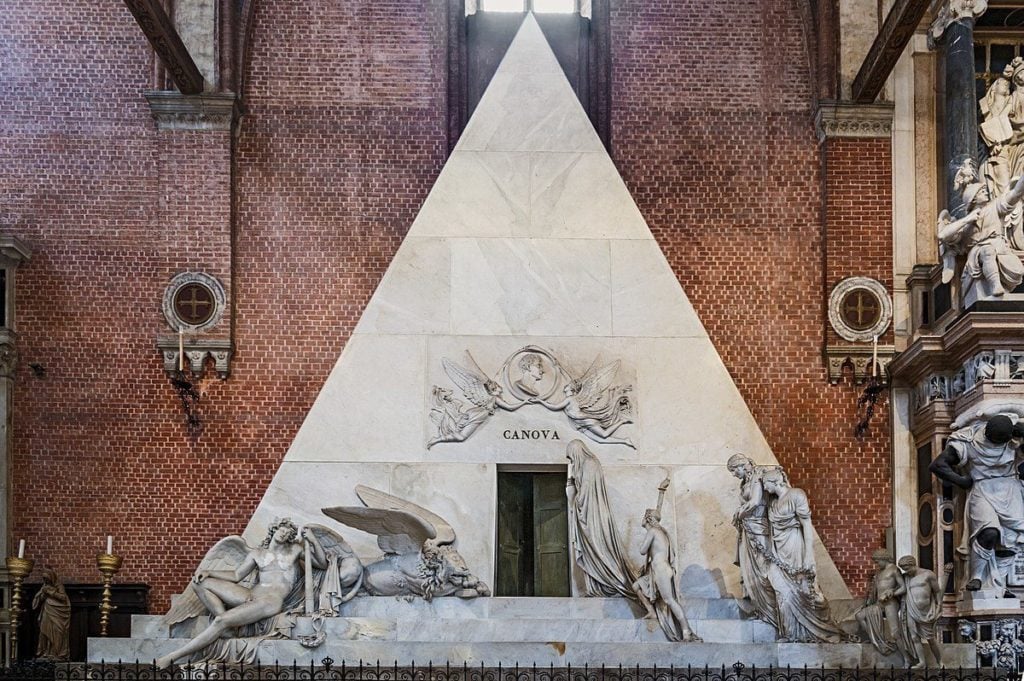
Italian neoclassical sculptor Antonio Canova’s funerary monument basilica di Santa Maria Gloriosa dei Frari, Basilica dei Frari, Venice, Italy. Courtesy of Flickr.
Date of Earthly Departure: October 13, 1822
Eternal Resting Place: Santa Maria Gloriosa dei Frari, Basilica dei Frari, Venice (at least some of him)
Deathly Details: Though the fervor for the Italian neoclassical sculptor has diminished in the nearly 200 years since his death, Canova enjoyed unparalleled artistic celebrity in his time—as evidenced by the elaborate (and frankly sort of bizarre) tomb erected for him by a group of his students. The monument itself is derived from designs Canova made for the tomb of Titian, but with symbols that reference his own association with Freemasonry, like a pyramidal entrance. Oh, and to make things even stranger, we should note that the only part of Canova entombed here is his heart. His death apparently invoked a relic-crazed zeal that resulted in the divvying up of the rest of his body.
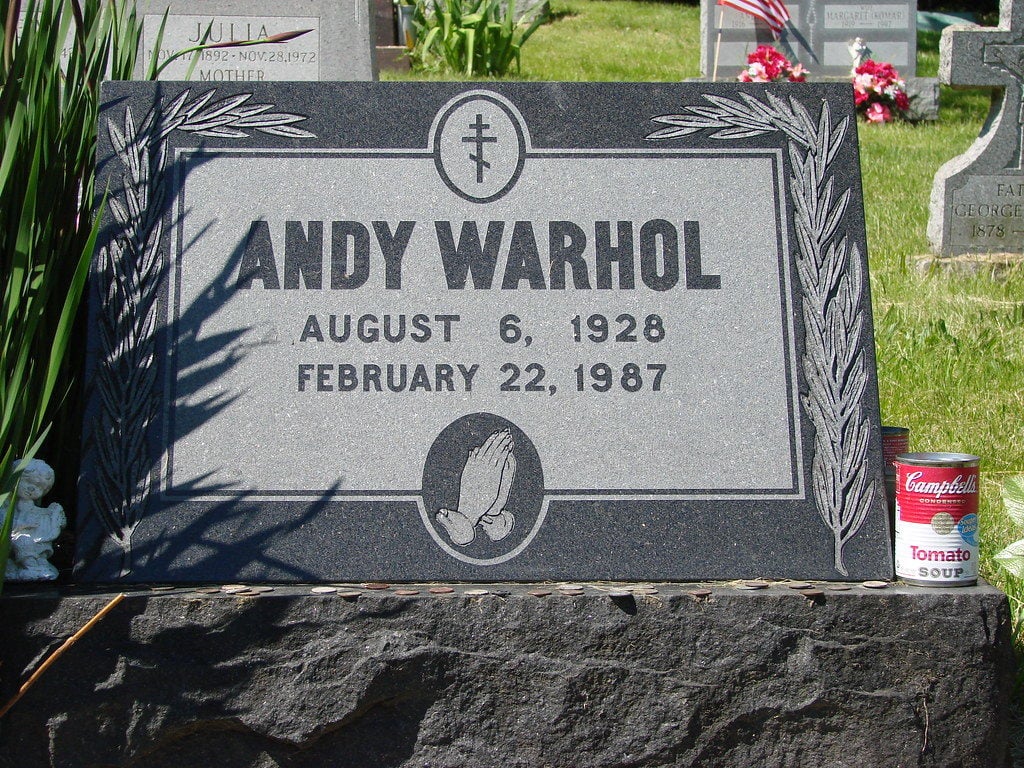
Andy Warhol’s tombstone at St. John the Baptist Byzantine Catholic Cemetery, Bethel Park, PA. Courtesy of Flickr.
Date of Earthly Departure: February 22, 1987
Eternal Resting Place: St. John the Baptist Byzantine Catholic Cemetery, Bethel Park, Pennsylvania
Deathly Details: The spirit of death hovered over all of Andy Warhol’s career. From the Pop icon’s “Death and Disaster” series to his attempted assassination, his life seemed a long flirtation with the grim reaper. And while one might expect his grave site to be something of a colorful culmination of this preoccupation, Warhol’s burial place in a Catholic cemetery alongside his parents seems the opposite of attention-grabbing—at least at first glance. For those in the know, however, Warhol’s cult of fame lives on. His grave site is live-streamed 24-hours a day by the St. John Chrysostom Byzantine Catholic Church.
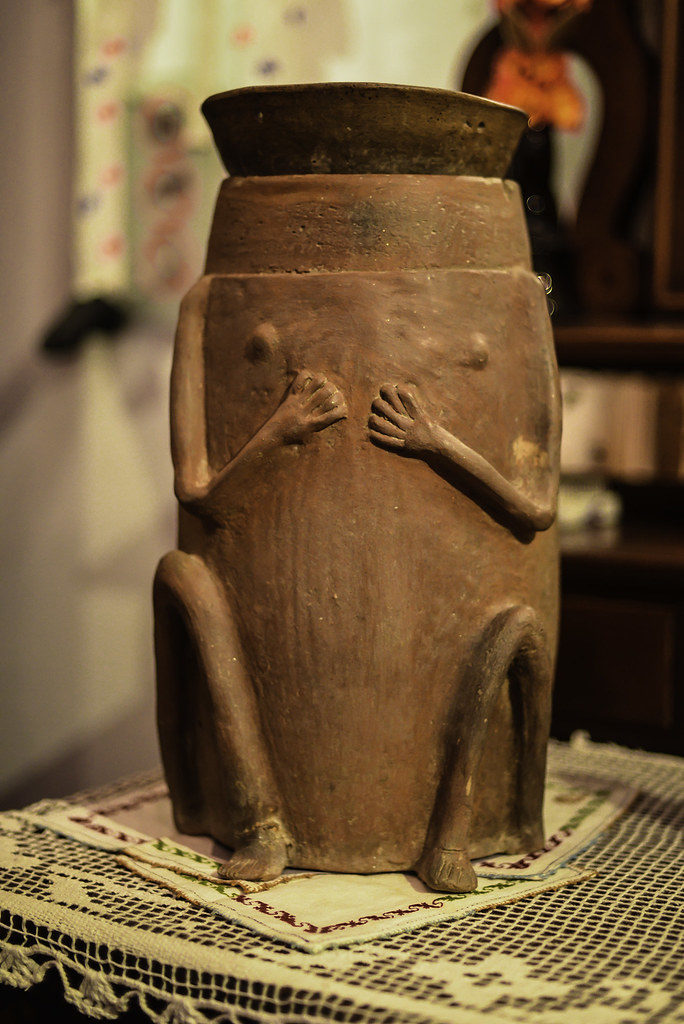
Frida Kahlo’s urn at her home, Casa Azul, in Mexico City. Courtesy of Flickr.
Date of Earthly Departure: July 13, 1954
Eternal Resting Place: a frog-shaped urn at her home in Mexico City
Deathly Details: After a tragic bus accident nearly killed her in her teenage years, Frida Kahlo’s brief life was marked by surgeries, illnesses, and immense physical suffering. Her last diary entry before she died at the age of 47 read: “I hope the exit is joyful—and I hope never to return—Frida.” Anticipating her death, Kahlo requested that her ashes be placed in a frog-shaped pre-Columbian urn and kept at her beloved home, Casa Azul, where they remain on display to this day.
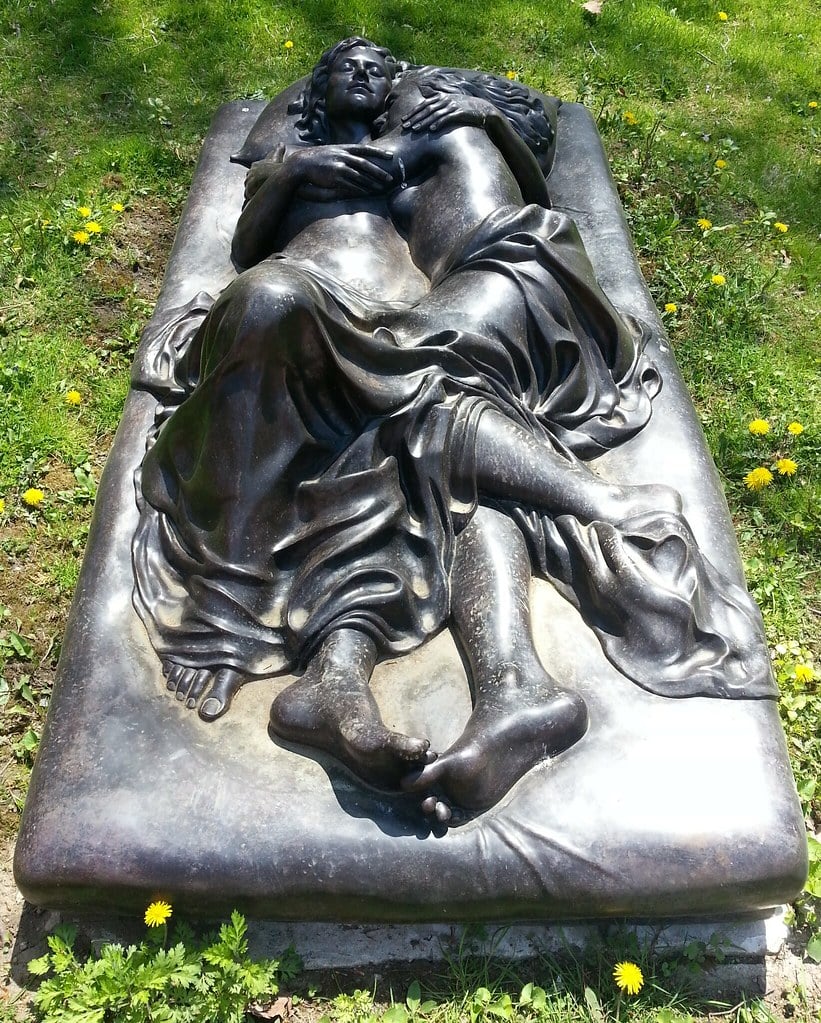
Patricia Cronin’s Memorial to a Marriage (2011) at Woodlawn Cemetery, Bronx, New York. Courtesy of Flickr.
Date of Earthly Departure: Fingers crossed for a far-off future
Eternal Resting Place: Woodlawn Cemetery in the Bronx
Deathly Details: Patricia Cronin has got to be a project manager’s dream. While many artists have been bequeathed with elegiac monuments many years after their deaths, Cronin has already got her sepulchral future all set. In 2011, the artist installed a bronze version of Memorial to a Marriage, a sculpture that depicts her and her wife, the artist Deborah Kass, embracing in bed, at a cemetery in the Bronx. The seemingly Etruscan-inspired tomb will mark the couple’s resting place whenever the time comes (hopefully a long time from now).
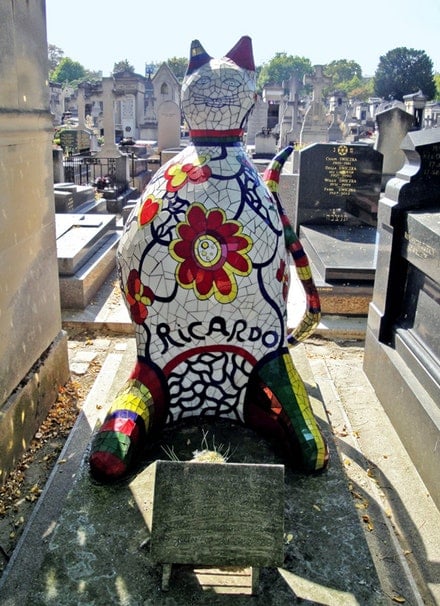
Tombstone designed by Niki de Saint Phalle for her studio assistant Ricardo Menon at Cimetière Montparnasse, Paris. Courtesy of Flickr.
Date of Earthly Departure: September 21, 1989
Eternal Resting Place: Cimetière de Montparnasse, Paris
Deathly Details: Second only to Père Lachaise Cemetery in the number of creative geniuses it boasts as permanent residents, Cimetière de Montparnasse is the chosen resting spot of Baudelaire, Sartre, and Brancusi, to name a few. But among all of these, the most eye-catching tombstone is certainly a dazzling white cat designed by the artist Niki de Saint Phalle for her dear friend and decade-long studio assistant Ricardo Menon. Menon worked with the French artist on her ebullient sculptural wonderland, the Tarot Garden, in Tuscany, and cared for Saint Phalle as she endured debilitating arthritis. Before Menon’s death from AIDS in 1989, Saint Phalle promised to make him a tombstone in the shape of a cat, the animal she most associated with him for its mysterious beauty.
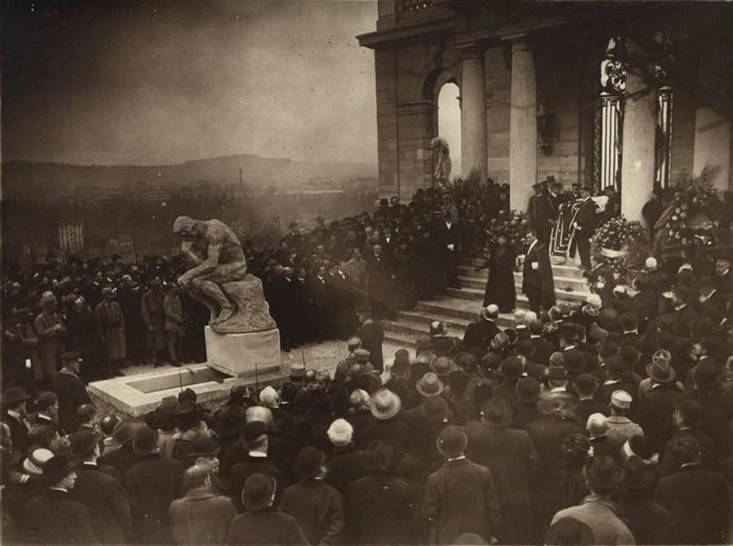
Pierre Choumoff, Rodin’s funeral (November 24, 1917). Courtesy of Wikimedia Commons.
Date of Earthly Departure: November 17, 1917
Eternal Resting Place: Beneath his cast of his sculpture The Thinker at what is now the Musée Rodin, Meudon, France
Deathly Details: Rodin’s most famous sculpture, The Thinker, garnered great acclaim as a societal symbol went it was first exhibited on a monumental scale Paris in 1904. But for the artist, the sculpture must have assumed a more tragically romantic significance as well. Just two weeks after Rodin married Rose Beuret, his lover of 53 years, she died on February 14, 1917 (yes, Valentine’s Day). She was buried in the grounds of his chateau in Meudon, France, and there, Rodin erected a smaller version of his Thinker. A few months later, Rodin died as well. He was buried alongside her.
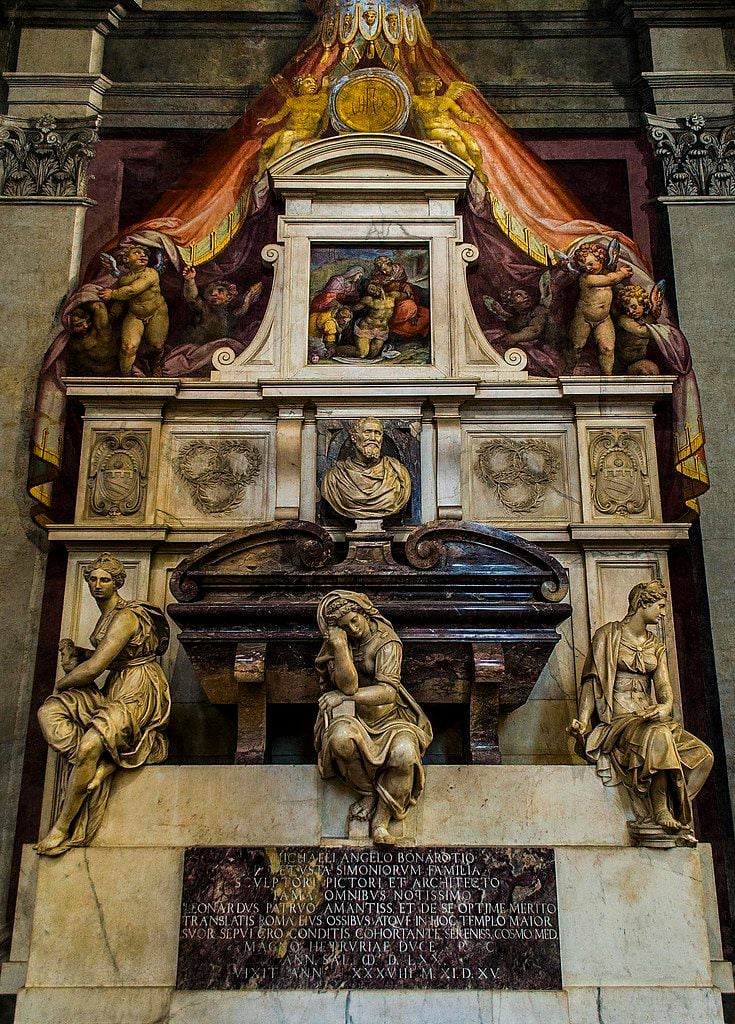
Michelangelo’s tomb at Basilica of Santa Croce in Florence. Courtesy of Wikimedia Commons.
Date of Earthly Departure: February 18, 1564
Eternal Resting Place: Basilica di Santa Croce, Florence
Deathly Details: When Michelangelo died in Rome at the age of 88, he’d been in a self-imposed exile from his beloved Florence since the 1530s, when Alessandro de’ Medici (whom Michelangelo considered a tyrant) had been made the first duke of Florence. Soon after Michelangelo was laid to rest in Rome, Duke Cosimo I de’ Medici decided to make amends and had the artist’s body brought back to Florence for a state burial and commemoration. In his honor, this monumental and decadent tomb, designed in part by Giorgio Vasari, was erected at the Church of Santa Croce. Crowning the monument are figures representing painting, sculpture, and architecture, each weeping over the death of the Renaissance master. Michelangelo rests in good company, with Galileo entombed just a few steps away.
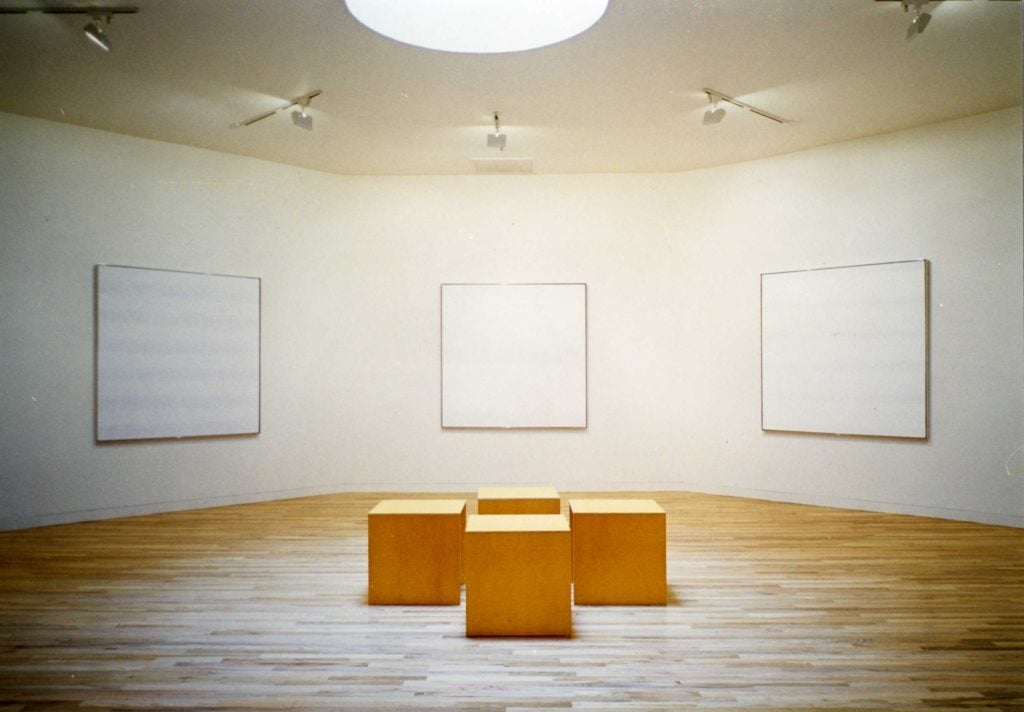
The Agnes Martin Gallery in the Harwood Museum of Art, with benches by Donald Judd. Courtesy of the Harwood Museum of Art, Taos.
Date of Earthly Departure: December 16, 2004
Eternal Resting Place: The courtyard of the Harwood Museum of Art, Taos, New Mexico
Deathly Details: Agnes Martin’s life in the New Mexico desert has taken on nearly mystical associations—but, if her burial is any indication, the southwestern town is also where she found some very loyal friends. In 1993, the artist created a special suite of paintings for Taos’s Harwood Museum of Art, and, before her death in 2004, asked that she be buried in the museum courtyard. That request, however, was forbidden by New Mexico state law. That’s why, in the spring after her death, a group of Martin’s devoted friends gathered past dark and, with a ladder, scaled the adobe walls of the museum. In the moonlight, they buried her ashes under an apricot tree, where they remain to this day.
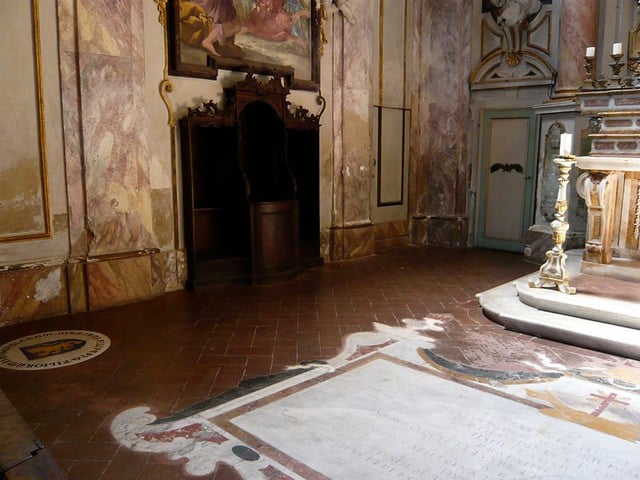
Botticelli is bured at Chiesa di San Salvatore in Ognissanti, Florence. His burial place is marked by the circular emblem on the floor, while the banner emblem marks the burial place of noblewoman Simonetta Vesspucci. Courtesy of Flickr.
Date of Earthly Departure: May 17, 1510
Eternal Resting Place: Chiesa di San Salvatore di Ognissanti, Florence
Deathly Details: Have you ever marveled at the ethereal beauty of Venus in Botticelli’s Birth of Venus and wondered whose likeness inspired it? Many suspect the figure is based on Italian noblewoman Simonetta Vespucci, of whom the 15th-century master was deeply enamored (others say that’s wishful thinking, as she’d been dead for a decade by the time he painted the picture). Regardless, Botticelli adored Vespucci, and before he died, asked to be buried at her feet. When he died in his 60s, his request was granted.
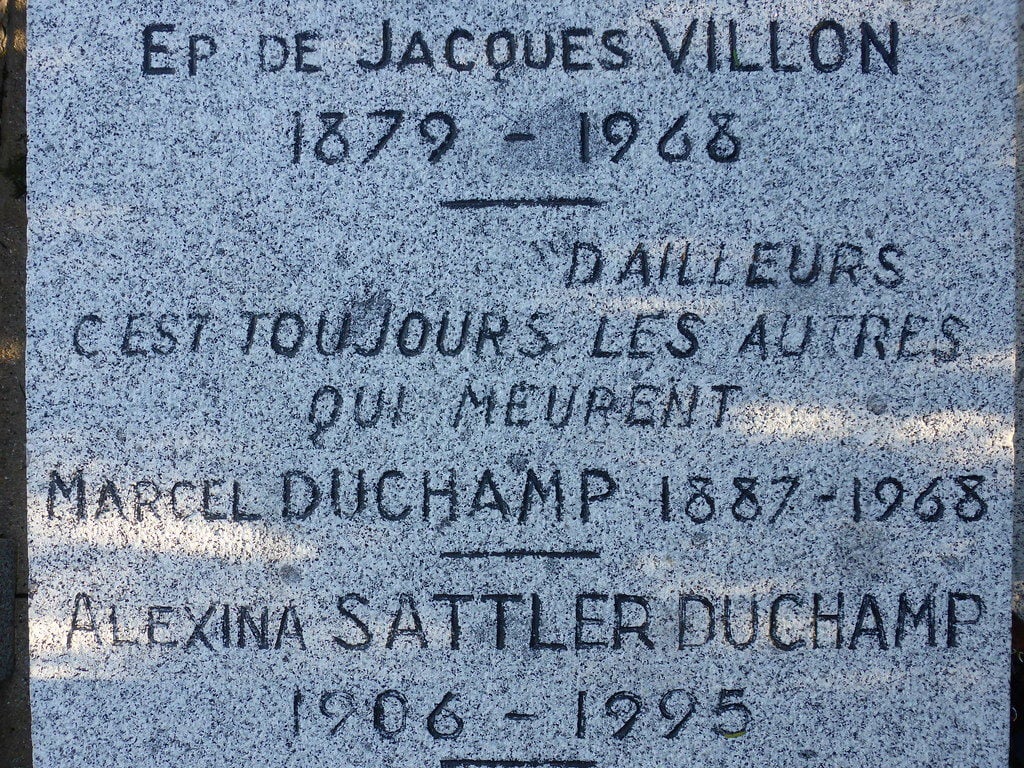
Marcel Duchamp’s headstone at Rouen Cemetery. Courtesy of Flickr.
Date of Earthly Departure: October 2, 1968
Eternal Resting Place: Rouen Cemetery, Roeun, France
Deathly Details: The Dada artist had a quick wit—even in death. After a night spent dining with photographer Man Ray and art critic Robert Lebel, Duchamp collapsed from a heart attack in his studio just past one in the morning. The devout atheist was buried at Rouen Cemetery in France and his tombstone bears the epitaph, “D’ailleurs, c’est toujours les autres qui meurent” or, “Besides, it’s always the others who die.”